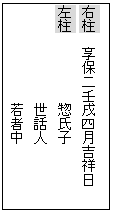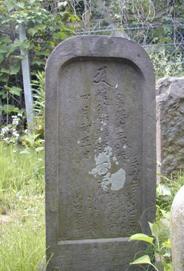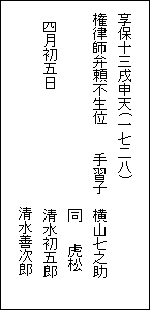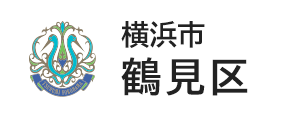現在位置
Last updated on July 9, 2024.
The text is from here.
17th: Sueyoshi Shrine

Kamisueyoshi Village, Tachibana-gun Old Story

Sueyoshi Shrine
Sueyoshi Shrine is located on the bus street at 4-chome Kamisuekichi, Tsurumi-ku. In April 1956, the Sueyoshi Shrine was renamed Sueyoshi Shrine by enshrining nearby Yahata Shrine and Kajiyama Shrine, centered on Mishima Shrine, which has long been enshrined at Kamisueyoshi Shrine. At the entrance, there is an old-colored Shinmei-style Ishidorii.
It was moved from the former Mishima Shrine. The former Mishima Shrine is described in "Musashi topographical record" as "Mishima Shrine character Nehata Niari Yamano half-abdomen two companies-building stone floor 19th grade 19th grade, regular festival September 19th Murauchi Enmyoji Mochi". At present, Sueyoshi Shrine has enshrined deity as Amaterasu Kotajin, but until the early Meiji era it was Gion Oyama.

In the shrine parishioner area, the former shrine parishioner is Kamisueyoshi and Shimosueyoshi and is now the entire Kamisueyoshi area. Shimosueyoshi in the former shrine parishioner was due to the fact that half of them used to guard Mishima Shrine. This, according to the monument, is said to tell the spirits of shrine parishioner's Mishima Shrine. In addition, about the time when Sueyoshi Village was divided into upper and lower companies, "Musashi topographical record" said, "Konomura Kokuha upper and lower svete one village Narishiga second-handed squirt, Masayasu Nomonoi Miruni Miruni Undakalezu Genroku era Nirigami and Shimono Nimura Nimura Niburo era" was performed during the period from Masayasu.
In the Tsurumi area, villages such as East-West Kitaterao and Baba were born at the same time by Terao branch villages. It is known that during this period, active village divisions were divided in the shogunate under the direct control of the Edo period.
On the other hand, this may indicate that the development of rural areas is progressing. In 1335 (1335), Terao Kozu (prefectural Kanazawabunko Kura) wrote the title of Sueyoshi lord Mishima Todaio, and it seems that Todaio Mishima was the priest of Mishima Taisha Shrine in Shizuoka Prefecture.
When I asked Mishima Taisha, I found that there are still two-class shrines, Too Mishima and Daio Nishi. Mishima Taisha was called Mishima Myojin in the old days, and was revered by Minamoto no Yoritomo, and it is clear from historical fact that he prayed to our company for victory when launching Izu.
There is no record that Yoritomo opened the Shogunate in Kamakura and gave his territory to the priest Mishima Myojin, who usually reverences. However, there are many Mishima Shrines founded in the land of Sagami, Sunzu and Musashi with Mishima Myojin as the axis. I believe that guardian god Mishima Shrine was founded in Sueyoshi as the existence of Todaio Mishima, the lord of Sueyoshi, as seen in the previous figure.

Benyori Shokozuka
At the end of the Warring States period, Yoshimura seems to have been a cold village under Ujiharu Hojo, Odawara. In Baba Village in the Tsurumi area, there was a castle for the fifth generation of Mikawanokami Suwa. There was also a residence of castle owner in Suwazaka, forming a castle town.
Tsurumi was also a key point on the highway as an inn station on the Tokaido, taking the Tsurumi River.
Also, in the Kamisueyoshi area, during the Kamakura period, when the Tsurumi battle between the Shogunate army and the Yoshisada Nitta army was held, small villages must have suffered great suffering during the war.
In the "Odawara Shuryokusho", there is "Mamiya Buzen Mamoru Yasushi 35 Kanbun, Kozukue Sueyoshi", etc., and where the small desk was located at Koki Castle in the Middle Ages, Michio Ota's attack on Koki Castle is famous in historical fact. .

Mr. Mamiya says in "Odawara Edition", "I live in Miyamura, the first Shinfuyu Izu-Takata-gun, and call Mr. Mamiya." It also says "Rokuju Rokukanbun, Edo Kawasaki", and it is said that during the Eiroku period, the Tama River flowed south of Kawasaki and flowed from the old market around Shitte and Hatchonawate.
Now, the Soto sect Sosanji Temple in Sunako Kawasaki has the Shinfuyu burial ground, and it is known that it was the territory of Mr. Mamiya at that time.
Enmyoji Temple (1-8 Kamisueyoshi) of Mishima Shrine (now Sueyoshi Shrine) is a temple in Shingon sect and is called Sueyoshi Santokoinmain deity. At the site of Enmyoji Temple, there is a brush mound of a monk Benyori who opened a Terakoya during the Edo period and taught his children.
This Benyori brush child mound is the second oldest brush mound in Yokohama city area. Enmyoji Temple was abandoned in 1873, and the cemetery remains slightly.
Tsurumi History Society / Tsukasa Okuma
From Tsurusho, Tsurumi Ward Cultural Association
Inquiries to this page
Tsurumi Ward General Affairs Department Ward Administration Promotion Division
Phone: 045-510-1680
Phone: 045-510-1680
Fax: 045-510-1891
E-Mail address tr-kusei@city.yokohama.lg.jp
Page ID: 157-605-066













